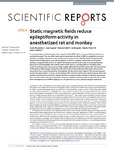| dc.contributor.author | Rivadulla, Casto | |
| dc.contributor.author | Aguilar, Juan | |
| dc.contributor.author | Coletti, Marcos | |
| dc.contributor.author | Aguila, Jordi | |
| dc.contributor.author | Prieto, Sandra | |
| dc.contributor.author | Cudeiro, Javier | |
| dc.date.accessioned | 2018-11-14T09:08:11Z | |
| dc.date.available | 2018-11-14T09:08:11Z | |
| dc.date.issued | 2018-10-30 | |
| dc.identifier.citation | Rivadulla C, Aguilar J, Coletti M, Aguila J, Prieto S, Cudeiro J. Static magnetic fields reduce epileptiform activity in anesthetized rat and monkey. Sci Rep. 2018;8:15985 | es_ES |
| dc.identifier.issn | 2045-2322 | |
| dc.identifier.uri | http://hdl.handle.net/2183/21286 | |
| dc.description.abstract | [Abstract] Increasing evidence indicates that static magnetic fields (SMF) reduce cortical activity in both human and animal models. The aim of this work was to investigate the effect of SMF on epileptiform cortical activity, a condition related to an abnormal increase in neuronal excitability. The first experimental block included a Pilocarpine rat model of epilepsy, in which a magnetic neodymium nickel-plated cylinder, a magnetic field of 0.5 T, or “sham” were placed over the skull. In the second experimental block, we recorded epileptic-like activity in the visual cortex of a monkey (Macaca mulatta) under control conditions and in the presence of the magnet. Between 15 and 30 minutes after the second dose of Pilocarpine, EEG changes compatible with seizure like events induced by Pilocarpine were clearly observed in the control animals (sham stimulation). Similar effects were visible in the animals exposed to the real magnet after 1–2 hours. In the monkey, SMF over the cortical focus clearly reduced abnormal activity: the intensity threshold for visual induction increased and the severity and duration decreased. These results reinforce the view that static magnets modulate cortical activity and open the door to the future therapeutic use of SMF in epilepsy as a complement to current pharmacological treatments. | es_ES |
| dc.description.sponsorship | This work was supported by the Ministerio de Economía y Competitividad, BFU2013-45343-P and BFU2017-82296-P. | es_ES |
| dc.description.sponsorship | info:eu-repo/grantAgreement/MINECO/Programa Estatal de Fomento de la Investigación Científica y Técnica de Excelencia/BFU2013-45343-P/ES/NEUROMODULACION MEDIANTE TECNICAS NO INVASIVAS Y SU APLICACION AL ESTUDIO DEL SISTEMA VISUAL EN PRIMATES NO HUMANOS: EFECTOS PSICOFISICOS Y NEURONALES | es_ES |
| dc.description.sponsorship | info:eu-repo/grantAgreement/AEI/Programa Estatal de Fomento de la Investigación Científica y Técnica de Excelencia/BFU2017-82296-P/ES/PAPEL DE LOS CIRCUITOS DE RETROALIMENTACION EN EL PROCESAMIENTO VISUAL Y LA MEMORIA DE TRABAJO | |
| dc.language.iso | eng | es_ES |
| dc.publisher | Nature | es_ES |
| dc.relation.uri | https://doi.org/10.1038/s41598-018-33808-x | es_ES |
| dc.rights | Creative Commons Attribution 4.0 International Licence (CC-BY 4.0) | es_ES |
| dc.rights.uri | http://creativecommons.org/licenses/by/4.0/ | * |
| dc.title | Static magnetic fields reduce epileptiform activity in anesthetized rat and monkey | es_ES |
| dc.type | info:eu-repo/semantics/article | es_ES |
| dc.rights.access | info:eu-repo/semantics/openAccess | es_ES |
| UDC.journalTitle | Scientific Reports | es_ES |
| UDC.volume | 8 | es_ES |
| UDC.startPage | 15985 | es_ES |







